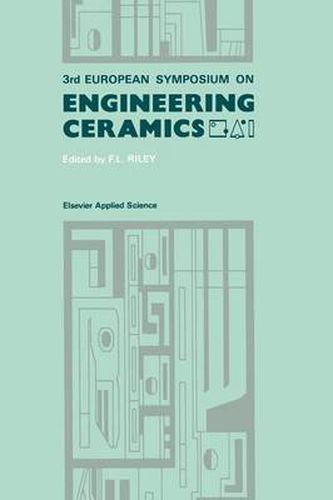Readings Newsletter
Become a Readings Member to make your shopping experience even easier.
Sign in or sign up for free!
You’re not far away from qualifying for FREE standard shipping within Australia
You’ve qualified for FREE standard shipping within Australia
The cart is loading…






This title is printed to order. This book may have been self-published. If so, we cannot guarantee the quality of the content. In the main most books will have gone through the editing process however some may not. We therefore suggest that you be aware of this before ordering this book. If in doubt check either the author or publisher’s details as we are unable to accept any returns unless they are faulty. Please contact us if you have any questions.
This volume is the proceedings of the 3rd European Symposium on Engineering Ceramics, held in London, 28-29 November 1989, under the auspices of IBC Technical Services Ltd. The Symposium sessions were chaired by Eric Briscoe, who also introduced the Symposium with the very appropriate review ‘Ceramics in Europe’. The term ‘engineering ceramics’ is commonly taken to mean a group of special high-strength and heat-resistant ceramic materials developed almost exclusively for the advanced internal combustion engine of the next century. It is not always fully appreciated that high grade fine microstructure ceramics both of the oxide and of the non-oxide classes, whether they be termed engineering, fine, special, advanced, structural or technical, have been supporting a large number of diverse and profitable industries over many decades. Indeed, in some respects these materials can be regarded as natural developments from the long established refractories field, and the distinction between an engineering ceramic and a refractory can become blurred, as the contribution in this volume on ‘Nitride Bonded Carbide Engineered Ceramics’ shows. It is of significance that in Japan, for example, much development work in the engineering ceramics field was initiated by the refractories industries, seeking to diversify possibly but doing so on the basis oflong experience in the refractories area. The main objective of this Symposium was to help engineers and designers to assess the present state of the field of engineering ceramics.
$9.00 standard shipping within Australia
FREE standard shipping within Australia for orders over $100.00
Express & International shipping calculated at checkout
This title is printed to order. This book may have been self-published. If so, we cannot guarantee the quality of the content. In the main most books will have gone through the editing process however some may not. We therefore suggest that you be aware of this before ordering this book. If in doubt check either the author or publisher’s details as we are unable to accept any returns unless they are faulty. Please contact us if you have any questions.
This volume is the proceedings of the 3rd European Symposium on Engineering Ceramics, held in London, 28-29 November 1989, under the auspices of IBC Technical Services Ltd. The Symposium sessions were chaired by Eric Briscoe, who also introduced the Symposium with the very appropriate review ‘Ceramics in Europe’. The term ‘engineering ceramics’ is commonly taken to mean a group of special high-strength and heat-resistant ceramic materials developed almost exclusively for the advanced internal combustion engine of the next century. It is not always fully appreciated that high grade fine microstructure ceramics both of the oxide and of the non-oxide classes, whether they be termed engineering, fine, special, advanced, structural or technical, have been supporting a large number of diverse and profitable industries over many decades. Indeed, in some respects these materials can be regarded as natural developments from the long established refractories field, and the distinction between an engineering ceramic and a refractory can become blurred, as the contribution in this volume on ‘Nitride Bonded Carbide Engineered Ceramics’ shows. It is of significance that in Japan, for example, much development work in the engineering ceramics field was initiated by the refractories industries, seeking to diversify possibly but doing so on the basis oflong experience in the refractories area. The main objective of this Symposium was to help engineers and designers to assess the present state of the field of engineering ceramics.